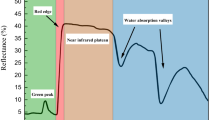Abstract
To counter the threat of hyperspectral detection, it is necessary to develop biomimetic materials to simulate the solar spectral reflection characteristics of plant leaf accurately. Two kinds of membranaceous yellow biomimetic materials were prepared by dispersing the particles of chrome titanium yellow and iron oxide yellow as fillers in polyvinyl alcohol films respectively. Reflectance and transmittance of the biomimetic materials were measured, and absorption and scattering coefficients of the biomimetic materials were inverted with a four-flux model. Results indicate that the biomimetic material adopting chrome titanium yellow particles can simulate the solar spectrum reflection characteristics of yellow leaf because of the similar absorption and scattering characteristics. The biomimetic material adopting iron oxide yellow particles cannot simulate the spectrum reflection characteristics of yellow leaf near the wavelength of 900 nm due to the characteristic absorption of the iron oxide. When the volume fraction of the chrome titanium yellow particles is lower than 2.12%, the absorption and scattering coefficients both increase approximately linearly with the volume fraction, indicating that the particles can scatter radiation independently. Therefore, the reflectance of the biomimetic material can be regulated through linearly changing of the volume fraction of the chrome titanium yellow particles.
Similar content being viewed by others
References
Khan M J, Khan H S, Yousaf A, Khurshid K, Abbas A. Modern trends in hyperspectral image analysis: A review. IEEE Access, 2018, 6, 14118–14129.
Shaw G, Manolakis D. Signal processing for hyperspectral image exploitation. IEEE Signal Processing Magazine, 2002, 19, 12–16.
Chiang S S, Chang C I, Ginsberg I W. Unsupervised target detection in hyperspectral images using projection pursuit. IEEE Transactions on Geoscience and Remote Sensing, 2001, 39, 1380–1391.
Yuen P W, Richardson M. An introduction to hyperspectral imaging and its application for security, surveillance and target acquisition. The Imaging Science Journal, 2010, 58, 241–253.
Zhang H, Zhang J C. Near-infrared green camouflage of cotton fabrics using vat dyes. The Journal of The Textile Institute, 2008, 99, 83–88.
Yang Y, Liu Z, Hu B, Man Y, Wu W. Bionic composite material simulating the optical spectra of plant leaves. Journal of Bionic Engineering, 2010, 7, S43–S49.
Qin R, Xu G, Guo L, Jiang Y, Ding R. Preparation and characterization of a novel poly(urea-formaldehyde) microcapsules with similar reflectance spectrum to leaves in the UV-Vis-NIR region of 300–2500 nm. Materials Chemistry and Physics, 2012, 136, 737–743.
Yuan Z, Ye H, Li S M. Bionic leaf simulating the thermal effect of natural leaf transpiration. Journal of Bionic Engineering, 2014, 11, 90–97.
Yang X, Tang J, Mustard J F, Wu J, Zhao K, Serbin S, Lee J E. Seasonal variability of multiple leaf traits captured by leaf spectroscopy at two temperate deciduous forests. Remote Sensing of Environment, 2016, 179, 1–12.
Ye H, Gao Y, Li S M, Guo L. Bionic leaves imitating the transpiration and solar spectrum reflection characteristics of natural leaves. Journal of Bionic Engineering, 2015, 12, 109–116.
Demarez V. Seasonal variation of leaf chlorophyll content of a temperate forest. Inversion of the PROSPECT model. International Journal of Remote Sensing, 1999, 20, 879–894.
Sims D A, Gamon J A. Relationships between leaf pigment content and spectral reflectance across a wide range of species, leaf structures and developmental stages. Remote Sensing of Environment, 2002, 81, 337–354.
Wang L, Habibi M, Eldridge J I, Guo S M. Infrared radiative properties of plasma-sprayed BaZrO3 coatings. Journal of the European Ceramic Society, 2014, 34, 3941–3949.
Maheu B, Letoulouzan J N, Gouesbet G. Four-flux models to solve the scattering transfer equation in terms of Lorenz-Mie parameters. Applied Optics, 1984, 23, 3353–3362.
Xu Y, Ma H, Peng S. Study on identification of altered rock in hyperspectral imagery using spectrum of field object. Ore Geology Reviews, 2014, 56, 584–595.
Viscarra Rossel R, Bui E, De Caritat P, McKenzie N. Mapping iron oxides and the color of Australian soil using visible- near-infrared reflectance spectra. Journal of Geophysical Research: Earth Surface, 2010, 115, F04031.
Gao Y, Ye H. Bionic membrane simulating solar spectrum reflection characteristics of natural leaf. International Journal of Heat and Mass Transfer, 2017, 114, 115–124.
Gates D M, Keegan H J, Schleter J C, Weidner V R. Spectral properties of plants. Applied Optics, 1965, 4, 11–20.
Randrianalisoa J, Baillis D. Analytical model of radiative properties of packed beds and dispersed media. International Journal of Heat and Mass Transfer, 2014, 70, 264–275.
Gunde M K, Orel Z C. Absorption and scattering of light by pigment particles in solar-absorbing paints. Applied Optics, 2000, 39, 622–628.
Molenaar R, ten Bosch J J, Zijp J R. Determination of Kubelka–Munk scattering and absorption coefficients by diffuse illumination. Applied Optics, 1999, 38, 2068–2077.
Cai Q, Ye H, Lin Q. Analysis of the optical and thermal properties of transparent insulating materials containing gas bubbles. Applied Thermal Engineering, 2016, 100, 468–477.
Acknowledgment
This work was funded by the National Natural Science Foundation (No. 51576188).
Author information
Authors and Affiliations
Corresponding author
Rights and permissions
About this article
Cite this article
Xu, K., Lin, Y., Wei, X. et al. Biomimetic Material Simulating Solar Spectrum Reflection Characteristics of Yellow Leaf. J Bionic Eng 15, 741–750 (2018). https://doi.org/10.1007/s42235-018-0062-4
Published:
Issue Date:
DOI: https://doi.org/10.1007/s42235-018-0062-4




